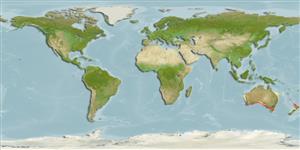Elasmobranquios (tiburones y rayas) (sharks and rays) >
Myliobatiformes (Stingrays) >
Urolophidae (Round rays)
Etymology: Trygonoptera: Greek, trygon = a sting ray + Greek, pteron = wing, fin (Ref. 45335); imitata: Name from Latin 'imitor', to copy or mimic, refers to its similarity to Trygonoptera mucosa and T. testacea in general appearance resulting in confusion over their identities..
More on authors: Yearsley, Last & Gomon.
Environment: milieu / climate zone / depth range / distribution range
Ecología
marino bentopelágico; rango de profundidad ? - 120 m (Ref. 76956). Temperate
Southern Oceans: Australia.
Length at first maturity / Tamaño / Peso / Age
Maturity: Lm 47.5, range 45 - 48.2 cm
Max length : 68.9 cm TL macho / no sexado; (Ref. 76956); 79.3 cm TL (female)
Inhabits bays and coastal waters from close inshore near beaches to depths of at least
120 m (Ref. 76956).
Life cycle and mating behavior
Maturities | Reproducción | Spawnings | Egg(s) | Fecundities | Larva
Yearsley, G.K., P.R. Last and M.F. Gomon, 2008. Trygonoptera imitata sp. Nov., a new stingaree (Myliobatoidei: Urolophidae) from Southeastern Australia. pp. 261-267. In P.R. Last, W.T. White and J.J. Pogonoski (eds). Descriptions of new Australian chondrichthyans. CSIRO Marine and Atmospheric Research Paper no. 22. 365 p. (Ref. 76956)
IUCN Red List Status (Ref. 130435)
Threat to humans
Harmless
Human uses
Herramientas
Special reports
Download XML
Fuentes de Internet
Estimates based on models
Preferred temperature (Ref.
123201): 14.6 - 18.4, mean 16 °C (based on 170 cells).
Phylogenetic diversity index (Ref.
82804): PD
50 = 0.5156 [Uniqueness, from 0.5 = low to 2.0 = high].
Bayesian length-weight: a=0.00692 (0.00399 - 0.01200), b=3.09 (2.93 - 3.25), in cm total length, based on LWR estimates for this species & (Sub)family-body (Ref.
93245).
Nivel trófico (Ref.
69278): 3.7 ±0.5 se; based on size and trophs of closest relatives
Fishing Vulnerability (Ref.
59153): Moderate to high vulnerability (52 of 100).
Nutrients (Ref.
124155): Calcium = 4.9 [0.7, 82.5] mg/100g; Iron = 0.193 [0.019, 2.258] mg/100g; Protein = 19.3 [14.0, 24.5] %; Omega3 = 0.349 [0.101, 1.025] g/100g; Selenium = 11.3 [2.1, 60.5] μg/100g; VitaminA = 11.2 [0.8, 144.1] μg/100g; Zinc = 0.455 [0.031, 5.072] mg/100g (wet weight);
